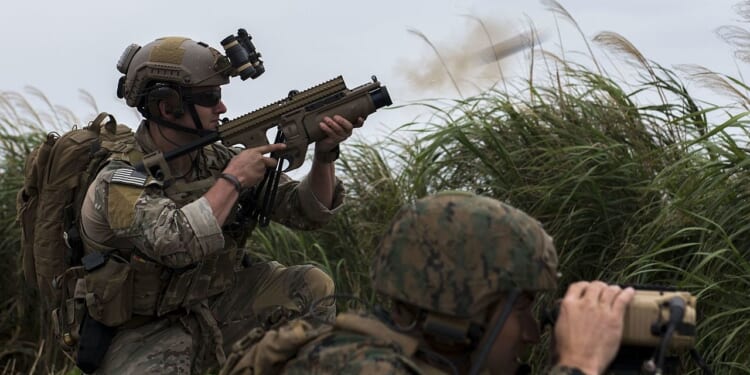Instead of being carried by specific “grenadiers” in a future assault, FN America touted how the MTL-30 could be employed in a variety of scenarios, including anti-drone warfare.
Beginning in the 17th century, “grenadiers” emerged as an elite type of infantry, charged with literally throwing grenades. They were noted for their height, strength, and courage, often serving as the vanguard in assaults on fortified positions. It is therefore fitting that the US Army’s future personal grenade launcher has been dubbed the “Precision Grenadier System,” which will enable the warfighter to engage in precision operations with “increased lethality.”
Last year, the service announced that firearms maker Barrett and firearms research and development company MARS had been selected to produce the new 30mm grenade rifle system, beating out an offering from FN America. The competition selected the two finalists after over a year and a half of technology pitches, including offerings from Colt and Northrop Grumman.
The US Army Is Giving FN America Another Chance
Even as the Army had selected the Squad Support Rifle System (SSRS) developed by Barrett and MARS earlier this month, it also awarded a Prototype Project Opportunity Notice (PPON) contract valued at $2 million to FN America. The contract called for FN America to “further develop its submission” to the PGS, the company announced.
The firearms maker will develop the FN Multi-Purpose Tactical Launch 30mm (MTL-30), a further evolution of its PGS-001. The new weapon system will be produced at the company’s facility in South Carolina.
The FN MTL-30, which an individual warfighter can carry, is a “semi-automatic, medium velocity, flat trajectory grenade launcher.” It weighs in at slightly more than 10 pounds and is 35 inches in length. Based on its appearance—including an adjustable M4-style telescoping stock, a modular MIL-STD Picatinny accessory rail, and a detachable box magazine—it could easily be mistaken for an assault rifle rather than a grenade launcher. That was certainly by design, and FN America noted that “real time soldier feedback” led to the prototype “incorporating a footprint” similar to the M4 carbine, including controls, grip, and buttstock. It is chambered for 30mm medium-velocity grenades, and has a capacity for three or five rounds.
“The technologies we have incorporated have allowed FN to create a system that is much lighter, more compact and more maneuverable than previous soldier-operated grenade launchers,” said Jim Williams, vice president for military programs at FN America. “This will improve soldier capabilities on the battlefield, offering a robust solution for close combat, engaging targets beyond 500m or to potentially combat other threats such as unmanned aerial systems.”
Who Would Use a Grenade Launcher Instead of a Rifle?
Instead of being carried by specific “grenadiers” in a future assault, FN America touted how the MTL-30 could be employed in a variety of scenarios, including “in close-quarter warfare, defeat[ing] targets in defilade, and engag[ing] unmanned aerial systems (UAS).” In the latter capacity, John Bungard, senior director for military development programs at FN America, explained that the weapon “could also be networked with FN remote weapons stations to create a multi-layered defense against UAS.”
The type of ordnance that could be employed with the FN MTL-30 hasn’t been disclosed. However, The War Zone reported that the PGS requirements called for the inclusion of “Counter Defilade Round,” which could engage adversaries in fortified positions, as well as armor-piercing and anti-drone ammunition.
The new contract doesn’t mean that the MTL-30 will be employed in combat anytime soon, but it does signal that the US Army is exploring multiple options for launching grenades on a future battlefield.
About the Author: Peter Suciu
Peter Suciu has contributed over 3,200 published pieces to more than four dozen magazines and websites over a 30-year career in journalism. He regularly writes about military hardware, firearms history, cybersecurity, politics, and international affairs. Peter is also a contributing writer for Forbes and Clearance Jobs. He is based in Michigan. You can follow him on Twitter: @PeterSuciu. You can email the author: [email protected].
Image: Wikimedia Commons.


















